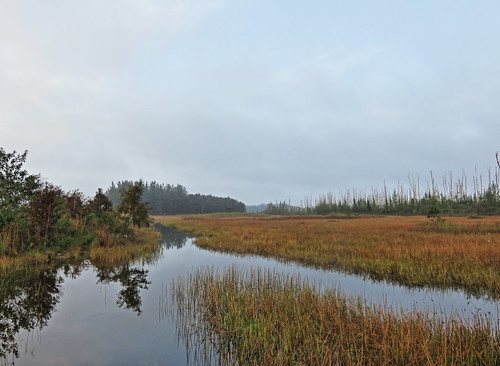
The rising Sun briefly broke through the cloud cover to illuminate the Pine Bank on the far end of the Wet Prarie, but rain never materialized:

During times of high water, the lake spills over into the Wet Prairie. Normally the water begins to recede after the end of summer. Lake levels have been unusually high for the past three years.
The entire prairie was still inundated in December, 2016

In October of 2017 the lake remained fairly high, but the water was confined to a slough created by an ATV trail.

On March 6th the lakeside marshes had nearly dried up, trapping many fishes which did not escape before being blocked off from the lake. The concentration of prey attracted herons, opossums, Bobcats, raccoons and even venomous Cottonmouth Water Moccasins, which subsist largely on carrion:

It was only a few minutes after sunrise, and the sun had not yet touched a little residual pool in the Wet Prairie. It was teeming with tiny life forms as evidenced by the ripples they created on the surface of the water.
I assumed that the larger fish had long ago escaped back into the lake or met their fate with predators and scavengers. Behind, they left their eggs and offspring to await an inevitable fate. It will probably be entirely dry within a week.
As I scanned the prairie, an immature Little Blue Heron flew in and settled atop a small Pond Cypress tree:

The heron's plumage might look as if soiled, but it is transitioning from its white immature plumage to the dark blue of an adult:

The "Little Blue" flew down to the pool, now appearing as liquid gold, reflecting the winter foliage in warm light. The heron immediately spotted its prey:


I recognized its catch as the tiny fry of the introduced Mayan Cichlid, one of the most common fish species in south Florida canals and lakes:

This fish is noted as a protective parent, defending its eggs and fry for several weeks, until their offspring grow to about 2 cm (3/4 inch). These babies appear to be a bit larger and were probably abandoned when the adults either escaped to open water or perished in the isolated pools or were taken by predators.

Native to Mexico and Central America, Mayan Cichlids are a good food source and most likely escaped from south Florida fish farms about 30-40 years ago.They can survive low oxygen levels but succumb if temperatures drop to near freezing.
A Tricolored Heron suddenly flew in to join in the feast:




The two species fed together amicably:

= = = = = = = = = = = = = = =
Linking to Misty's CAMERA CRITTERS,
Linking to Eileen's SATURDAY'S CRITTERS,
Linking to SKYWATCH FRIDAY by Yogi, Sylvia and Sandy
Linking to WEEKEND REFLECTIONS by James
Linking to BirdD'Pot by Anni
Linking to Our World Tuesday by Lady Fi
Linking to Wild Bird Wednesday by Stewart
Linking to Wordless Wednesday (on Tuesday) by NC Sue
Linking to ALL SEASONS by Jesh
________________________________________________
Please visit the links to all these memes to see some excellent photos on display
________________________________________________